13 Constructing Arguments
Consider the following argument:
- All humans are mortal
- All mortal things die
- Therefore, all humans die
Categorical logic is the logic that deals with the logical relationship between categorical statements. A categorical statement is simply a statement about a category or type of thing. For example, the first premise of the above argument is a statement about the categories of humans and things that are mortal. The second premise is a statement about the categories of things that are mortal and things that die. Finally, the conclusion is a statement about humans and things that die. Although you may think that this argument as a similar form as a hypothetical syllogism, it is distinct from a hypothetical syllogism because the premises are not composed of two different atomic propositions. Rather, each premise contains only one atomic proposition.
In categorical logic, the logical terms (analogous to the truth functional operators of propositional logic) are the terms “all” and “some.” In contrast with propositional logic, in categorical logic we will use capital letters to stand for categories of things in the world, rather than for atomic propositions. Thus, we can represent the statement:
All humans are mortal
as
All H are M
where “H” stands for the category of “humans” and “M” stands for the category, “things that are mortal.” Notice that the categories are nouns or noun phrases. Thus, instead of saying that the category is “mortal” I said the category is “things that are mortal.” It is important to recognize the difference between how the capital letters are being used in categorical logic and how they were used in propositional logic. In categorical logic, the capital letters stand for noun phrases that denote categories of things in the world—for example, “cars” or “things that are man-made” or “mammals” or “things that are red.”
In categorical logic, we will use what are called Venn diagrams to represent the logical relationships between the different kinds of categorical statements. A Venn diagram is simply a way of graphically representing the logical relationship between two different categorical statements. Below is a Venn diagram that represents the statement, “all humans are mortal.”
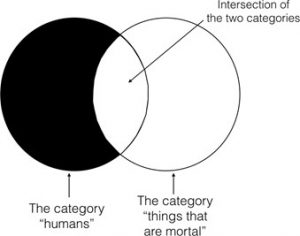 Here is how to understand this Venn. There are two circles that represent the two categories, “humans” and “things that are mortal.” These two categories are overlapping so that the intersection of those two categories (i.e. the place where the two circles overlap) represents things that are both human and mortal. Any shaded portions of the Venn diagram (by “shaded” I will mean “blacked out”) represent that there is nothing in that area of the category. So the above Venn says that there is nothing in the category “humans” that is not also in the category “things that are mortal.” The above Venn also allows that there are things that are in the category “things that are mortal” but that aren’t in the category “humans” (which is as it should be since, of course, dogs are mortal and yet not human). So the reason the category “things that are mortal” is left unshaded is that in saying “all humans are mortal” I leave open the possibility that there are things that are not human and yet mortal.
Here is how to understand this Venn. There are two circles that represent the two categories, “humans” and “things that are mortal.” These two categories are overlapping so that the intersection of those two categories (i.e. the place where the two circles overlap) represents things that are both human and mortal. Any shaded portions of the Venn diagram (by “shaded” I will mean “blacked out”) represent that there is nothing in that area of the category. So the above Venn says that there is nothing in the category “humans” that is not also in the category “things that are mortal.” The above Venn also allows that there are things that are in the category “things that are mortal” but that aren’t in the category “humans” (which is as it should be since, of course, dogs are mortal and yet not human). So the reason the category “things that are mortal” is left unshaded is that in saying “all humans are mortal” I leave open the possibility that there are things that are not human and yet mortal.
As noted above, the statement, “all humans are mortal,” has a particular form:
All H are M.
This is one of the four categorical forms. The way we will represent these categorical forms generally are with an “S” (which stands for “subject term”) and a “P” (which stands for “predicate term”). Thus, the categorical statement, “all humans are mortal,” has the following categorical form:
All S are P
The way we interpret statements of this form are as follows: everything in the category S is also in the category P. This statement form is what we call a “universal affirmative,” since it is a universal statement that does not contain a negation. There are three other categorical statement forms that you will have to become familiar with in order to do categorical logic. Here they are (with the name of the type of statement in parentheses to the right:
No S are P (universal negative)
Some S are P (particular affirmative)
Some S are not P (particular negative)
Here are three examples of statements that have these three forms (respectively):
No reptiles give live birth
Some birds are taller than President Obama
Some birds don’t fly
Notice that although these three statements don’t have exactly the same form as the statement forms above, they can be translated into those same forms. All we have to do is figure out the noun phrase that describes each category that the statement is referring to. Let’s start with “no reptiles give live birth.” This categorical statement refers to two different categories: the category of “reptiles” and the category of “things that give live birth.” Notice, again, that I added “things that…” to the predicate of the sentence (“give live birth”) because “give live birth” is not a description of a category. Rather, the way of describing the category is with the noun phrase, “things that give live birth.” Using these two category descriptions, we can translate this sentence to have the same form as its categorical form. All we have to do is substitute in the name of the subject category (i.e., the “S” term) and the description of the predicate category (i.e., the “P” term). Doing that will yield the following sentence:
No reptiles are things that give live birth
Although this sentence sounds strange in English, it has the same form as the categorical form, no S are P, and this translation allows us to clearly see that it does and thus to see what the two categories are. Here is what the Venn diagram for this statement looks like:
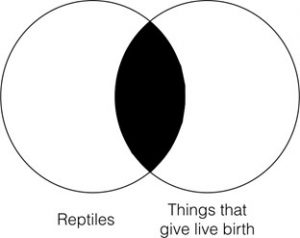
This Venn diagram represents that there is nothing in the intersection of the two categories, “reptiles” and “things that give live birth.” If you think about it, this is exactly what our original statement was saying: there isn’t anything that is both a reptile and gives live birth.
Let’s look at the next statement, “some birds are taller than President Obama.” This is a statement not about all birds, but about some birds. What are the two categories? One category is clearly “birds.” The other category is “things that are taller than President Obama.” That may sound like a strange category, but it is perfectly legitimate category. It includes things like adult ostriches, large grizzly bears standing on their hind legs, giraffes, the Flatiron Building, a school bus, etc. Here is how we’d translate this sentence using our two categories:
Some birds are things that are taller than President Obama.
Again, although this sentence sounds strange in English, it has the same form as the categorical form, some S are P, and it allows us to clearly see what the two categories are. Below is the Venn diagram for this statement:

By convention, an asterisk on the Venn diagram means that there is at least one thing in that category. By putting the asterisk in the intersection of the two categories, we are saying that there is at least one thing that is a bird and is taller than President Obama, which is exactly what our original sentence was saying.
Finally, let’s consider the statement, “some birds don’t fly.” How would we translate this sentence to have the “some S are not P” form? The first step is to
get the descriptions of the two categories using either nouns or noun phrases. The “S” term is easy; it is just “birds” again. But we have to be a bit more careful with the “P” term, since its predicate contains a negation. We do not want any of our categories to contain a negation. Rather, the negation is contained in the form (i.e., the “not”). The category cannot be simply “fly” or even “flies” since neither of these are a category of thing. We have to use our trick of turning the predicate into a noun phrase, i.e., “things that fly.” Given these two category descriptions, we can then translate the sentence to have the categorical form, some S are not P:
Some birds are not things that fly
Again, although the English sounds clunky here, it has the same form as the categorical form, some S are not P, and it allows us to clearly see what the two categories are. Below is the Venn diagram for this statement:
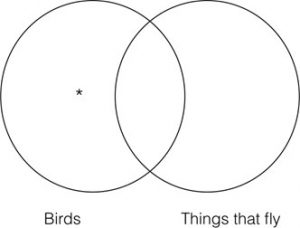
By convention, an asterisk on the Venn diagram means that there is at least one thing in that category. By putting the asterisk inside the “birds” category, but outside the “things that fly” category, we are representing that at least one thing that is a bird isn’t a thing that flies. This is exactly what our original sentence was saying.
Translating categorical statements into their categorical form can by tricky. In fact, it is probably one of the trickier things you’ll do in formal logic. There is no simple way of doing it other than asking yourself whether your translation accurately captures the meaning of the original English sentence. Here is an example of a tricky categorical statement:
Nobody loves me but my mother.
This is a categorical statement, but which of the four categorical forms does it have? The first step is to ask what two categories are being referred to in this sentence. Here are the two categories: “things that love me” and “things that are my mother.” Notice that the category couldn’t just be “my mother” since that isn’t a category; it’s a particular thing. Again, this sounds strange, but it is important to remember that we are describing categories of things. The next question is: what is this sentence saying is the relationship between these two categories? Hint: it has to be one of the four categorical forms (since any categorical statement can be translated into one of these four forms). The sentence is saying that the only things that love me are things that are my mother. The categorical form of the statement is the “all S are P” form. Thus, the sentence, translated into the correct categorical form would be:
All things that love me are things that are my mother.
We will end this section with one last example. Consider the following categorical statement:
The baboon is a fearsome beast.
Which of the four categorical forms does this statement have? Although the article “the,” which often denotes particulars, may lead one to think that this is a particular affirmative form (some S are P), it is actually a universal affirmative form (all S are P). This English sentence has the sense of “baboons are fearsome beasts” rather than of “that (particular) baboon is a fearsome beast.” English is strange, which is what makes translation one of the trickiest parts of logic. So, the two categories are: “baboons” and “fearsome beasts.” Notice that since “fearsome beasts” is already a noun phrase, we don’t have to add “things that are…” to it. Using the two category descriptions, the translation into the “all S are P” categorical form is thus:
All baboons are fearsome beasts.
In this section we have learned what categorical statement are, how to translate categorical statements into one of the four categorical forms, and how to construct Venn diagrams for each of the four categorical forms. The following exercises will give you some practice with the translation part; in subsequent sections we will learn how to use Venn diagrams as a formal method of evaluating a certain class of arguments.
Exercise: Translate each of the following sentences into one of the four categorical forms (universal affirmative, universal negative, particular affirmative, particular negative). Make sure that the descriptions of the two categories are nouns or noun phrases (rather than adjectives or verbs).
- Real men wear pink.
- Dinosaurs are not birds.
- Birds evolved from dinosaurs.
- Some mammals are not predators.
- Some predators are not mammals.
- Not all who wander are lost.
- All presidents are not women.
- Boxers aren’t rich.
- If someone is sleeping then they aren’t conscious.
- If someone is conscious then they aren’t sleeping.
- All’s well that ends well.
- My friends are the only ones that care.
- Someone loves you.
- Jesus loves everyone.
- Jesus loves the little children.
- Some people don’t love Jesus.
- Only pedestrians may use the Appalachian Trail.
- Only citizens can be president.
- Anyone who is a Hindu believes in God.
- Anything that is cheap is no good.
- Some expensive things are no good.
- Not all mammals have legs.
- There are couples without children.
- There are no people who hate chocolate.
- There are people who hate cats.
- Nothing that is sharp is safe.
- No poodle could run faster than a cheetah.
- No professional runner is slow.
- Baboons aren’t friendly.
- Pigs will eat anything.
The Venn test of validity for immediate categorical inferences
In the last section, we introduced the four categorical forms. Those forms are below.




We can use Venn diagrams in order to determine whether certain kinds of arguments are valid or invalid. One such type of argument is what we will call “immediate categorical inferences.” An immediate categorical inference is simply an argument with one premise and one conclusion. For example:
- Some mammals are amphibious.
- Therefore, some amphibious things are mammals.
If we construct a Venn diagram for the premise and another Venn diagram for the conclusion, we will see that the Venn diagrams are identical to each other.


That is, the information that is represented in the Venn for the premise, is exactly the same information represented in the Venn for the conclusion. This argument passes the Venn test of validity because the conclusion Venn contains no additional information that is not already contained in the premise Venn. Thus, this argument is valid. Let’s now turn to an example of an invalid argument.
- All cars are vehicles.
- Therefore, all vehicles are cars.
Here are the Venns for the premise and the conclusion, respectively:


In this case, the Venns are clearly not the same. More importantly, we can see that the conclusion Venn (on the right) contains additional information that is not already contained in the premise Venn. In particular, the conclusion Venn allows that a) there could be things in the “car” category that aren’t in the “vehicle” category and b) that there cannot be anything in the “vehicle” category that isn’t also in the “car” category. That is not information that is contained in the premise Venn, which says that a) there isn’t anything in the category “car” that isn’t also in the category “vehicle” and b) that there could be things in the category “vehicle” that aren’t in the category “car.” Thus, this argument does not pass the Venn test of validity since there is information contained in the conclusion Venn that is not already contained in the premise Venn. Thus, this argument is invalid.
The Venn test of validity is a formal method, because we can apply it even if we only know the form of the categorical statements, but don’t know what the categories referred to in the statements represent. For example, we can simply use “S” and “P” for the categories—and we clearly don’t know what these represent. For example:
- All S are P
- No P are S


The conclusion (on the right) contains information that is not contained in the premise (on the left). In particular, the conclusion Venn explicitly rules out that there is anything that is both in the category “S” and in the category “P” while the premise Venn allows that this is the case (but does not require it). Thus, we can say that this argument fails the Venn test of validity and thus is invalid. We know this even though we have no idea what the categories “S” and “P” are.
This is the mark of a formal method of evaluation.
Exercise: Apply the Venn test of validity in order to determine whether the following categorical inferences are valid or invalid.
-
- All S are P; therefore, all P are S
- Some S are P; therefore, some P are S
- Some S are P; therefore, some P are not S
- Some S are P; therefore, all P are S
- No S are P; therefore, no P are S
- No P are S; therefore, some S are P
- Some S are not P; therefore, some P are not S
- All S are P; therefore some P are not S
Universal statements and existential commitment
Consider the following inference:
-
- All S are P
- Therefore, some S are P
Is this inference valid or invalid? As it turns out, this is an issue on which there has been much philosophical debate. On the one hand, it seems that many times when we make a universal statement, such as “all dogs are mammals,” we imply that there are dogs—i.e., that dogs exist. Thus, if we assert that all dogs are mammals, that implies that some dogs are mammals (just as if I say that everyone at the party was drunk, this implies that at least someone at the party was drunk). In general, it may seem that “all” implies “some” (since some is encompassed by all). This reasoning would support the idea that the above inference is valid: universal statements imply certain particular statements. Thus, statements of the form “all S are P” would imply that statements of the form “some S are P.” This is what is called “existential commitment.”
In contrast to the reasoning just laid out, modern logicians reject existential commitment; they do not take statements of the form “all S are P” to imply that there exists anything in the “S” category. Why would they think this? One way of understanding why universal statements are interpreted in this way in modern logic is by considering laws such as the following:
All trespassers will be fined.
All bodies that are not acted on by any force are at rest.
All passenger cars that can travel 770 mph are supersonic.
The “S” terms in the above categorical statements are “trespassers,” “bodies that are not acted on by any force,” and “passenger cars that can travel 770 mph.” Now ask yourself: do these statements commit us to the existence of either trespassers or bodies not acted on by any force? No, they don’t. Just because we assert the rule that all trespassers will be fined, we do not necessarily commit ourselves to the claim that there are trespassers. Rather, what we are saying is anything that is a trespasser will be fined. But this can be true, even if there are no trespassers! Likewise, when Isaac Newton asserted that all bodies that are not acted on by any force remain at rest, he was not committing himself to the existence of “bodies not acted on by any force.” Rather, he was saying that anything that is a body not acted on by any force will remain in motion. But this can be true, even if there are no bodies not acted on by any force! (And there aren’t any such bodies, since even things that are stationary like your house or your car parked in the driveway are still acted on by forces such as gravity and friction.) Finally, in asserting that all passenger cars that can travel 770 mph are supersonic, we are not committing ourselves to the existence of any such car. Rather, we are only saying that were there any such car, it would be supersonic (i.e., it would travel faster than the speed of sound).
For various reasons (that we will not discuss here), modern logic treats a universal categorical statement as a kind of conditional statement. Thus, a statement like,
All passenger cars that can travel 770 mph are supersonic
is interpreted as follows:
For any x, if x is a passenger car that can travel 770 mph then x is supersonic.
But since conditional statements do not assert either the antecedent or the consequent, the universal statement is not asserting the existence of passenger cars that can travel 770 mph. Rather, it is just saying that if there were passenger cars that could travel that fast, then those things would be supersonic.
We will follow modern logic in denying existential commitment. That is, we will not interpret universal affirmative statements of the form “All S are P” as implying particular affirmative statements of the form “some S are P.” Likewise, we will not interpret universal negative statements of the form “no S are P” as implying particular negative statements of the form “some S are not P.” Thus, when constructing Venn diagrams, you can always rely on the fact that if there is no particular represented in the premise Venn (i.e., there is no asterisk), then if the conclusion Venn represents a particular (i.e., there is an asterisk), the argument will be invalid. This is so since no universal statement logically implies the existence of any particular. Conversely, if the premise Venn does represent a particular statement (i.e., it contains an asterisk), then if the conclusion doesn’t contain particular statement (i.e., doesn’t contain an asterisk), the argument will be invalid.
Exercise: Construct Venn diagrams to determine which of the following immediate categorical inferences are valid and which are invalid. Make sure you remember that we are not interpreting universal statements to imply existential commitment.
-
- All S are P; therefore, some S are P
- No S are P; therefore, some S are not P
- All S are P; therefore, some P are S
- No S are P; therefore, some P are not S
Venn validity for categorical syllogisms
A categorical syllogism is just an argument with two premises and a conclusion, where every statement of the argument is a categorical statement. As we have seen, there are four different types (forms) of categorical statement:
All S are P (universal affirmative)
No S are P (universal negative)
Some S are P (particular affirmative)
Some S are not P (particular negative)
Thus, any categorical syllogism’s premises and conclusion will be some mixture of these different types of statement. The argument I gave at the beginning of section 2.13 was a categorical syllogism. Here, again, is that argument:
-
- All humans are mortal
- All mortal things die
- Therefore, all humans die
As we can see now that we have learned the four categorical forms, each one of the statements in this syllogism is a “universal affirmative” statement of the form, “all S are P.” Let’s first translate each statement of this argument to have the “all S are P” form:
-
- All humans are things that are mortal.
- All things that are mortal are things that die.
- All humans are things that die.
In determining the validity of categorical syllogisms, we must construct a three category Venn diagram for the premises and a two category Venn diagram for the conclusion. Here is what the three category Venn looks like for the premises:

We need a three category Venn for the premises since the two premises refer to three different categories. The way you should construct the Venn is with the circle that represents the “S” category of the conclusion (i.e., the category “humans”) on left, the circle that represents the “P” category of the conclusion (i.e., the category “things that die”) on the right, and the remaining category (“things that are mortal”) in the middle, as I have done above. Constructing your three category Venn in this way will allow you to easily determine whether the argument is valid.
The next thing we must do is represent the information from the first two premises in our three category Venn. We’ll start with the first premise, which says “all humans are things that are mortal.” That means that we must shade out anything that is in the “human” category, but that isn’t in the “things that are mortal” category, like this:

The next thing we have to do is fill in the information for the second premise, all things that are mortal are things that die. That means that there isn’t anything that is in the category “things that are mortal” but that isn’t in the “things that die” category. So we must shade out all of the parts of the “things that are mortal” category the lie outside the “things that die” category, like this:
The next thing we have to do is construct a two category Venn for the conclusion and then compare the information represented by the three category Venn for the premises to the two category Venn for the conclusion.

The conclusion represents the information that there is nothing in the “humans” category that isn’t also in the “things that die” category. It also allows that there are things that die, but that aren’t humans. The premise Venn also includes this same information, since every part of the “humans” category that is outside the “things that die” category is shaded out. Thus, this argument passes the Venn test of validity and is thus valid since there is no information represented in the conclusion Venn that is not also represented in the premise Venn. Notice that it doesn’t matter that the premise Venn contains more information than the conclusion Venn. That is to be expected, since the premise Venn is representing a whole other category that the conclusion Venn isn’t. This is perfectly allowable. What isn’t allowable (and thus would make an argument fail the Venn test of validity) is if the conclusion Venn contained information that wasn’t already contained in the premise Venn. However, since this argument does not do that, it is valid.
Let’s try another one.
1. All pediatricians are doctors
2. All pediatricians like children
3. Therefore, all doctors like children.
The first step is to identify the three categories referred to in this categorical syllogism. They are:
Pediatricians Doctors
Things that like children
The next step is to fill out the three category Venn for the premises and the two category Venn for the conclusion.

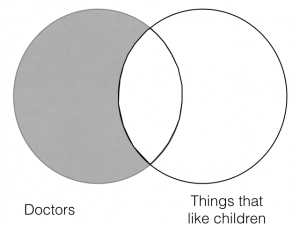
This argument does not pass the Venn test of validity because there is information contained in the conclusion Venn that is not contained in the premise Venn. In particular, the conclusion says that there is nothing in the “doctors” category that is outside the “things that like children category.” However, the premises do not represent that information, since the section of the category “doctors” that lies outside of the intersection of the category “things that like children” is unshaded, thus representing that there can be things there.
Sometimes when filling in particular statements on a three category for the premises, you will encounter a problem that requires another convention in order to accurately represent the information in the Venn. Here is an example where this happens:
1. Some mammals are bears
2. Some two-legged creatures are mammals
3. Therefore, some two-legged creatures are bears
There are three categories referred to in this categorical syllogism:
Mammals
Bears
Two-legged creatures
As always, we will put the “S” term of the conclusion on the left of our three category Venn, the “P” term on the right, and the remaining term in the middle, as follows:
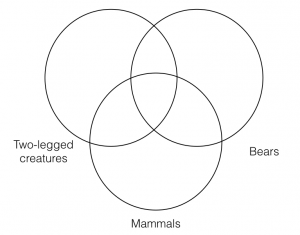
Now we need to represent the first premise, which means we need to put an asterisk in the intersection of the “mammals” and “bears” categories. However, here we have a choice to make. Since the intersection of the “bears” and “mammals” categories contains a section that is outside the “two-legged creatures” category and a section that is inside the “two-legged creatures” category, we must choose between representing the particular as part of the “two-legged creatures” category or not.
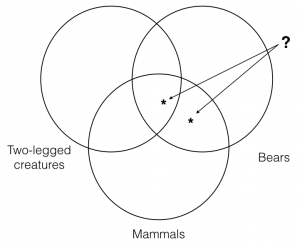 But neither of these can be right, since the first premise says nothing at all about whether the thing that is both a bear and a mammal is two-legged! Thus, in order to accurately represent the information contained in this premise, we must adopt a new convention. That convention says that when we encounter a situation where we must represent a particular on our three category Venn, but the premise says nothing about a particular category, then we must put the asterisk on the line of that category as I have done below. When we do this, it will represent that the particular is neither inside the category or outside the category.
But neither of these can be right, since the first premise says nothing at all about whether the thing that is both a bear and a mammal is two-legged! Thus, in order to accurately represent the information contained in this premise, we must adopt a new convention. That convention says that when we encounter a situation where we must represent a particular on our three category Venn, but the premise says nothing about a particular category, then we must put the asterisk on the line of that category as I have done below. When we do this, it will represent that the particular is neither inside the category or outside the category.
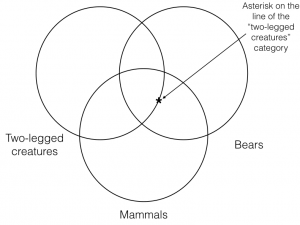
We must do this same thing for the second premise since we encounter the same problem there. Thus, when putting the asterisk in the intersection of the “two-legged creatures” and “mammals” categories, we cannot put the asterisk either inside or outside the “bears” category. Instead, we must put the asterisk on the line of the “bears” category. Thus, using this convention, we can represent the premise Venn and conclusion Venn as follows:
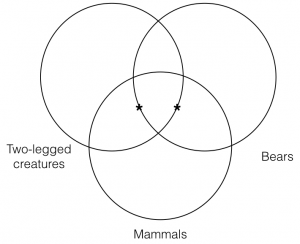

Keeping in mind the convention we have just introduced, we can see that this argument fails the Venn test of validity and is thus invalid. The reason is that the conclusion Venn clearly represents an individual in the intersection of the “two- legged creatures” and “bears” categories, whereas the premise Venn contains no such information. Thus, the conclusion Venn contains information that is not contained in the premise Venn, which means the argument is invalid.
We will close this section with one last example that will illustrate an important strategy. The strategy is that we should always map universal statements before mapping particular statements. Here is a categorical syllogism that illustrates this point. This time I am going to switch to just using the capital letters S, P, and M to represent the categories. Recall that we can do this because the Venn test of validity is a formal evaluation method where we don’t have to actually understand what the categories represent in the world in order to determine whether the argument is valid.
1. Some S are M
2. All M are P
3. ∴ Some S are P
If we think about mapping the first premise on our three category Venn, it seems that we will have to utilize the convention we just introduced, since the first premise is a particular categorical statement that mentions only the categories S and M and nothing about the category P:

However, as it turns out, we don’t have to use this convention because when we map premise 2, which is a universal statement, this clears up where the asterisk has to go:
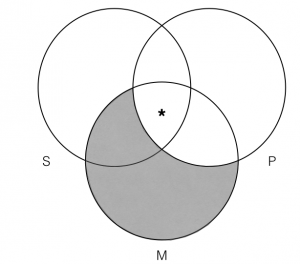

We can see that once we’ve mapped the universal statement onto the premise Venn (on the left), there is only one section where the asterisk can go that is in the intersection of S and M. The reason is that once we have mapped the “all M are P” premise, and have thus shaded out any portion of the M category that is
outside the P category, we know that that asterisk cannot belong inside the M category, given that it has to be inside the P category. When we apply the Venn test of validity to the above argument, we can see that it is valid since the conclusion Venn does not contain any information that isn’t already contained in the premise Venn. The conclusion simply says that there is some thing that is both S and P, and that information is already represented in our premise Venn. Thus, the argument is valid. The point of strategy here is that we should always map our universal statements onto our three category Venns before mapping our particular statements. The reason is that the universal can determine how we map our particular statements (but not vice versa).
Exercise 21: Use the Venn test of validity to determine whether the following syllogisms are valid or invalid.
. All M is P
All M is S
∴ All S is P
2. All P is M
All M is S
∴ All S is P
3. All M is P
Some M is S
∴ Some S is P
4. All P is M
Some M is S
∴ Some S is P
5. All P is M
Some S is M
∴ Some S is P
6. All P is M
Some S is not M
∴ Some S is not P
7. All M is P
Some S is not M
∴ Some S is not P
8. All M is P
Some M is not S
∴ Some S is not P
9. No M is P
Some S is M
∴ Some S is not P
10. No P is M
Some S is M
∴ Some S is not P
11. No P is M
Some S is not M
∴ Some S is not P
12. No M is P
Some S is not M
∴ Some S is not P
13. No P is M
Some M is not S
∴ Some S is not P
14. No P is M
No M is S
∴ No S is P
15. No P is M
All M is S
∴ No S is P
16. No P is M
All S is M
∴ No S is P
17. All P is M
No S is M
∴ No S is P
18. All M is P
No S is M
∴ No S is P
19. Some M is P
Some M is not S
∴ Some S is not P
20. Some P is M
Some S is not M
∴ Some S is P

